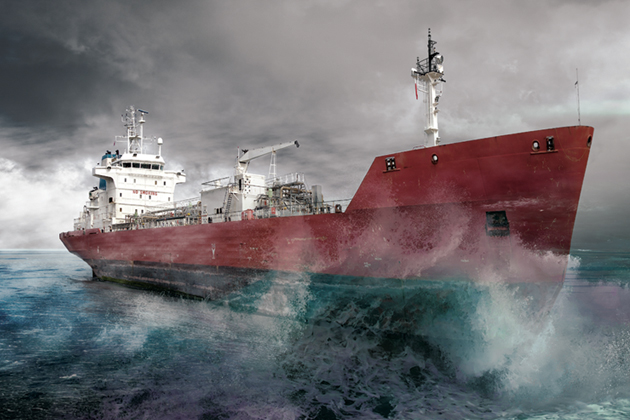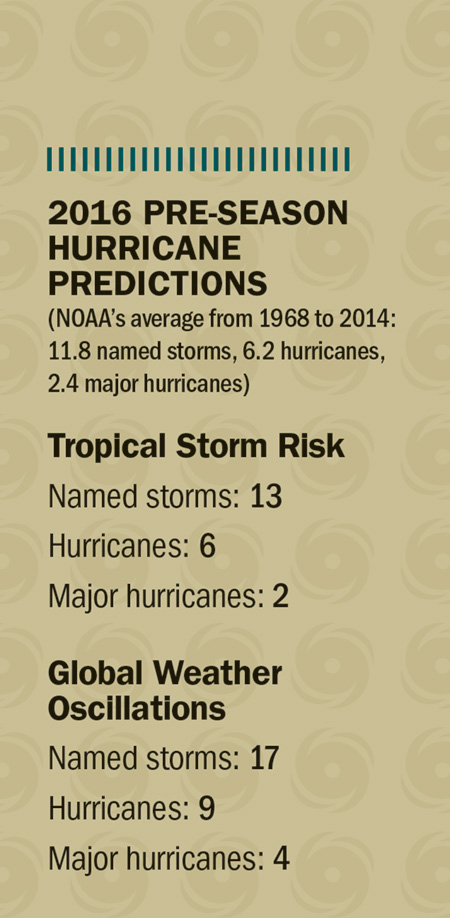
While extreme weather events can affect all kinds of businesses, hurricanes and tropical storms are especially serious considerations for risk management professionals in the shipping and transport industries—and, by extension, the entities they may serve. As demonstrated last year by the fate of the El Faro, a cargo ship that was lost at sea during Hurricane Joaquin, even if a storm does not make landfall, maritime freight operations and ports still face notable risks. Effective planning is essential to avoid expensive damage and loss claims and potential repercussions for the entire supply chain.
The Challenges of Hurricane Forecasting
This year, we again face the uncertainty of determining the number of hurricanes that will make landfall, where they will do so and how strong they will be. Outlooks have been complicated by the fact that researchers have to consider the effects of the El Niño Southern Oscillation (ENSO) and a possible shift from the more active period that began in 1995 to a less active period. Accurately determining how this will affect the hurricane season is challenging because of the year-to-year variability in the tropics and the combination and interaction of ENSO and other climate factors. There are no absolutes when it comes to hurricane predictability.
Check out more on the factors impacting this year's hurricane season outlook.
Operational Considerations
The Atlantic hurricane season typically runs from the beginning of June to the end of November, and the Pacific typhoon season from May to October. This means hurricanes and typhoons are in full force somewhere for at least half of the calendar year. Major storms can strike at any time, however, as illustrated by Hurricane Alex, which formed in the Atlantic Ocean this past January.
Regardless of the location or timing, there is an ongoing need for all ports, terminals and similar facilities to monitor, review and test plans and procedures, and to ensure that equipment is in the appropriate condition to withstand storms. Extreme storms are usually predicted several days in advance, giving operators valuable time to take action to prevent the worst damage, but experience suggests that these events require constant vigilance concerning general operational standards. This would include, for example, ensuring that container cranes are pinned or tied down when not in use in ports and that operators are instructed on actions to take in case of unexpected wind gusts.
Risk mitigation is important in preparation for storm conditions. It is particularly valuable to look at the way space is used and how goods and equipment are organized. For containerized operations, arrangements need to be made to ensure that containers are stacked in ports or loaded on ships effectively, even if it limits capacity. While contractual conditions may be sympathetic to storm conditions (typically with “force majeure” defenses), thorough preparations are proven to reduce the exposure of individual entities and their insurers.
Supply chain professionals may also be able to adjust the volume of cargo traffic coming in and out of ports during forecasted storm conditions. When extreme conditions are expected in high-risk regions, such as the Gulf of Mexico, logisticians may reduce imports and increase exports, ensuring that as much as possible is secured or delivered rather than in transit. Managed well, stormy weather need not cause any notable variation in cargo traffic, however, and the logistical ramifications of good traffic control can minimize operational liability for ships, ports and transport operations in general.
 Protecting the Port
Protecting the Port
An analysis by transport and logistics provider TT Club indicates that weather-related claims accounted for 13% of the cost of all claims in the international supply chain between 2010 and 2015. This ranges from maritime incidents leading to collapse of container stow or loss of cargo overboard, to property damage at ports, such as quay cranes being blown along the berth or empty containers being blown from stacks. One of the most significant aspects of damage arises from ships berthed alongside ports.
There is no doubt that the impact of severe weather can be mitigated. It is critical that effective local forecasting is available, particularly in view of the prevalence of microbursts (small downdrafts within thunderstorms that can cause extensive damage). It is also crucial for port operators to ensure that gantry crane brakes are all fully operational. Most cranes are designed for the gantry brakes to hold the crane against a 35 meter-per-second (78 miles-per-hour) wind. In many instances, however, it has been discovered post-incident that the brakes were not all working properly, resulting in the crane being blown along the berth even at lesser wind speeds.
While the general perception is that an empty container, which weighs two tons, is reasonably stable, storm conditions can rapidly dislodge exposed units and move them around a terminal facility, causing significant damage to obstacles in their path. As part of general good housekeeping, port-side terminals and even inland facilities should have a properly thought-out policy for container stacking. High stacks, particularly of empty containers, are vulnerable to high winds. In general it is therefore better to routinely stack containers lower and wider to avoid the need for emergency re-stacking as a storm approaches.
 Changing weather patterns have resulted in more severe storms occurring in locations where they have not been recorded historically, so it is strongly advised that every littoral port set in place emergency procedures for when a storm above a certain severity is forecast. For example, many ports have established emergency procedures to send ships out to sea when extreme weather conditions are forecast, although account needs to be taken of the size of the ship and its ability to ride out the storm. River ports may require different procedures.
Changing weather patterns have resulted in more severe storms occurring in locations where they have not been recorded historically, so it is strongly advised that every littoral port set in place emergency procedures for when a storm above a certain severity is forecast. For example, many ports have established emergency procedures to send ships out to sea when extreme weather conditions are forecast, although account needs to be taken of the size of the ship and its ability to ride out the storm. River ports may require different procedures.Where ships remain at the berth, emergency procedures should account for the potential need for additional mooring lines, and ensure that supplies are available to obtain and replace broken mooring. Tugboats may also need to be on standby to help secure a ship at the berth if mooring lines do not hold.
One of the most important issues to be considered is storm-related water damage due to precipitation or, most likely, from storm surges. Water damage is often difficult to prevent where cyclonic swells and tides or flooded river deltas surge into the terminal areas, which are necessarily at the water’s edge. With the possible consequences of rising sea levels and more flooding due to climate change, these issues should be investigated when locating and designing future terminals. For existing ports, habitually ensuring that drains and roof gutters are clear is just the first step to risk mitigation.
When extreme weather is anticipated, equipment should be moved from the most exposed areas and empty units placed at the bottom of container stacks. There are instances where rapid action in advance of impending storms has substantially reduced the resultant loss and—more importantly for any commercial venture—disruption. After all, a sound emergency plan will extend all the way to recovery of full operations.
Determining Acceptable Risk
Logisticians need to take into account that more than two-thirds of the globe’s surface is water. This is not only directly important for goods transported by the maritime system, but also because storms emanate from the sea mass surrounding land. It is difficult to adjust operations to allow for an acceptable level of risk on a journey from, for example, Florida to Buenos Aires, where hurricane risk volatility potentially varies from 1% to 20%. Play it conservatively by reducing cargo volume and a ship might arrive safely at its destination after experiencing calm seas. Heighten the risk appetite and the disruption and liabilities for cargo damage and loss could outweigh the potential capacity gains. Extreme weather conditions demand respect for the devastating forces unleashed, and as is so often the case, awareness, consideration and preparation are key to avoiding losses.
